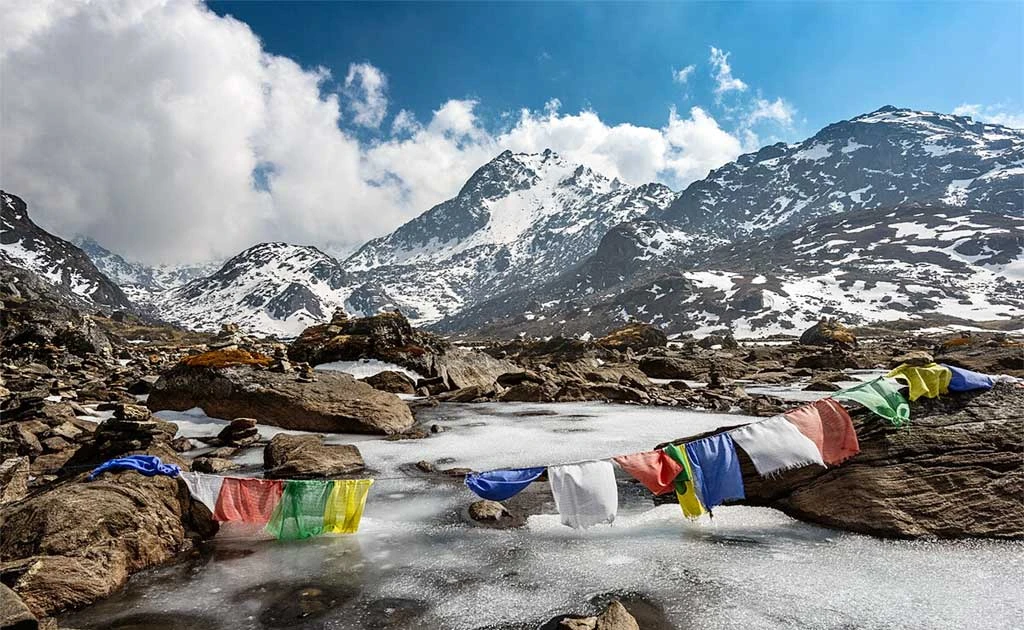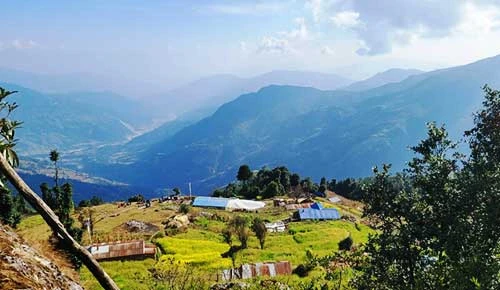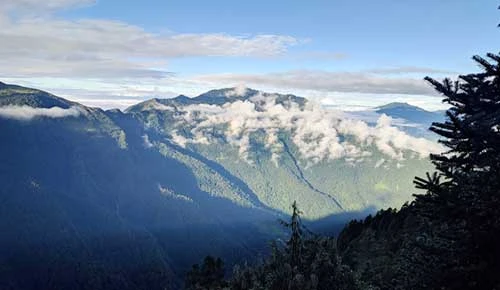Gosaikunda Lake Travel Guide
Gosaikunda Lake is located within the Langtang National Park at an elevation of around 4,380m. The lake, surrounded by rocky hills and snow-capped mountains, is well known for its blue water and calm environment. It is among the most elegant alpine lakes in Nepal and other people visit it, including trekkers and pilgrims, annually.
Gosaikunda is a sacred place in the narratives of Lord Shiva for Hindus and Buddhists. Thousands of pilgrims trek into the lake, especially during the Janai Purnima festival, to bathe where they believe that the icy cold waters cleanse them of their sins and reward them with blessings. Simultaneously, nature lovers even visit the place for the adventure, mountainous views, and peaceful getaway from busy routines.
Traveling to Gosaikunda is not only about the destination of a lake but also the trip itself. It leads you through lost villages, medieval forests of rhododendron and high passes until you emerge to the sparkling water of the lake. The Gosaikunda has its own adventure to remember and experience long after your trek ends, whether it's religion, sightseeing, or exploration.
Best Season For Gosaikunda Lake
Spring (March–May)
Gosaikunda can be visited in this month as one of the best times. Days are not so cold as during winter, and skies are normally clear, providing great views of the mountain. The woodlands along the path are alive with rhododendrons, magnolias, and other wild flowers, which make the journey colored and vibrant. The weather is comfortable for walking, and there are always enough fellow trekkers on the trail, making it quite sociable.
Autumn (September–November)
The trekking season is best in autumn in Nepal, and Gosaikunda is no exception. The weather is clear, with clear blue skies and excellent visibility. The monsoon is over; the air is fresh and filled with crispness and mountains look their clearest. This is also the most active period, when trekkers from around the world typically come to experience the best conditions. Even festivals such as Dashain and Tihar take place during this period; hence, you might see some local festivals going on on the trail.
Summer/monsoon (June–August)
Gosaikunda is difficult to visit during monsoon. The rain causes the trails to be muddy and slippery and leeches may be an issue at lower bunds. The views are usually hindered by the presence of clouds; however, the landscape becomes rich in green cover and falls at their peak, too. It can even be a good time for the person who can tolerate some rain and likes quiet trails. During the season of Janai Purnima, a festival with thousands of Hindu and Buddhist pilgrims going to the lake during monsoon despite the rains is celebrated in season.
Winter (December–February)
Winter is cold with profuse snow in the land of Gosaikunda. Trails can be rough and snowcapped high passes can close. Nevertheless, frozen lakes and snowy landscapes are beautiful and enchanting. This season is for those who are well-prepared, experienced in trekking, and seeking solitude away from crowds. Qualification and warm clothing are essential in case of your choice at this time.
How to reach Gosaikunda Lake?
Treks to Gosaikunda Lake are a combination of road and on-foot travel. The lake is located within Langtang National Park; hence, you cannot access it with a direct road; instead, you have to hike there. The journey typically begins in Kathmandu, which is the starting point for two common routes to the lake.
Here is how you can reach there:
Road Travel: Kathmandu to Dhunche
Dhunche, a small town in the Rasuwa district, is the most common starting point. By bus or jeep, it is 6–7 hours from Kathmandu to Dhunche. The road is rocky and zigzagging, but it passes through beautiful hills, rivers, and towns. It will take you 2 to 3 days to trek to Gosaikunda, depending on the speed at which you want to travel home from Dhunche.
Kathmandu-Sundarijal-Trekking through Helambu
The alternative will be to travel one hour out of Kathmandu to Sundarijal, close to the fringe of Shivapuri National Park. Then you begin hiking in the Helambu region through the villages such as Chisapani, Kutumsang, and Thadepati before arriving at Gosaikunda. The road is longer, taking 5 to 7 days to travel, and offers a more diverse range of landscape experiences.
Food and Accommodation in Gosaikunda Lake
Accommodation and food in the Gosaikunda area are basic and sufficient to render the trek comfortable. At the trail there are tea houses and lodges run by families that offer simple meals, both local and international. Dal Bhat, a typical Nepal dish of rice, lentil soup, and vegetables, is the most common food that can provide the needed energy to go on a trek. You can also take noodles, soups, Tibetan bread, pancakes and occasionally, fried rice or pasta. The higher you go, the menu becomes less elaborate and the prices slightly higher, as the things all have to be carried up by the porter or mule. However, there is still nothing quite like a hot meal at the end of a long day in the mountains and the teahouses always have a cup of tea or coffee as well as warm soup that is sure to keep you warm in the mountain breezes.
The basic but friendly accommodation is available, and teahouses provide small wooden rooms, thin mattresses, and warm blankets. Facilities that seem to have been slightly upgraded, such as attached bathrooms or the odd hot shower, can sometimes be found at lower altitudes, but as you get to higher villages and Gosaikunda itself, the rooms are about The accommodations are as basic as possible, and the toilets are typically shared. You sit by the fire, talk to trekkers or locals, and enjoy the mountain silence outside.
Although services cannot be described as luxurious, the tea house hospitality enhances the experience of trekking. The temperature of its food, the humble accommodation, and the greetings of the local people will make the experience feel genuine and memorable.
Major Attractions in Gosaikunda Lake
- Sacred Gosaikunda Lake with pristine waters
- Bhairab Kund and Saraswati Kund nearby
- Panoramic views of Langtang Lirung & Ganesh Himal peaks
- Lush alpine meadows and rhododendron forests
- Traditional Tamang villages along the trails
- Rich Himalayan wildlife spotting
- Scenic trekking paths with mountain vistas
- Frozen lake views in winter
- Stunning sunrises and sunsets over the mountains
Things to Do In Gosaikunda Lake
Trek to Gosaikunda Lake
The trek itself is also another big portion of the experience. The trek begins at Dhunche or Sundarijal and winds through pine and rhododendron forests and traditional Tamang and Sherpa villages, crosses rivers and ascends high-level ridges. Each step will provide the trekkers with scenery that constantly changes and may vary between lush green valleys and rocky mountains.
Holy Bath In Gosaikunda Lake
Gosaikunda is a sacred place and many take a sacred and ritual bath in the freezing waters, especially during the Janai Purnima festival. Christians consider the water to cleanse sins and act as a blessing. You do not need to take part in the ritual, but witnessing the festival or experiencing the spiritual fervor is a special event in itself and will enrich your trek.
Explore the Surrounding Lakes
Besides Gosaikunda, there are some others like Bhairab Kund and Saraswati Kund in the surrounding lakes. These smaller lakes are less crowded and more tranquil, providing an excellent location to relax or reflect, or maybe take a few photos. Both have beauty in their own ways and a walk between them gives one a different view of the Himalayan landscape.
Watch Sunset and Sunrise
The countryside and the lake diffuse the amazing hues of the sunset and dawn. Sunrises reflect in silky pink and orange at the surface of the water; sunsets can make the peaks gold. Such moments are ideal to take photographs, to meditate, or to just have time to absorb the calm atmosphere.
Visit Alpine Meadow.
There are open meadows with wildflowers and grass in the highlands along the track. They also offer ideal resting or picnic places, and the expansive panoramas of valleys and ridges render the hike even more gratifying. Trying these meadows, one feels unrestricted and in touch with nature.
Hikes within Rhododendron Forests
The trail goes through rhododendron forests during springtime in full blossom. The pink, white, and red blooms stand out in the best way possible against the green. These forests are cool and shady, and even during the non-bloom periods of the year, they are a welcome relief.
Spot wildlife.
There are enormous numbers of Himalayan animals found in Langtang National Park. Langurs are playful, and trekkers can observe colorful birds, shy cold musk deer, and occasionally red pandas or other rare animals. Listening to wildlife makes the trek more thrilling and makes one enjoy even more the natural riches of the park.
Meditation and Reflection
The calm and serene environment of Gosaikunda is perfect for quiet reflection or meditation. Sitting by the lake, listening to the wind, and watching the water or mountains can be deeply relaxing and spiritually refreshing, giving trekkers a moment to disconnect from everyday life.
Available Packages
Nepal Trek Adventures (NTA) is one of the professional agencies that make the planning of a trek to Gosaikunda Lake simple. With decades of experience conducting treks in Nepal, NTA conducts safe, comfortable and well-guided treks for trekkers of all levels. As a symbol of the natural theme in NTA tours, whether it be a short adventure, religious experience, or challenging high-pass trek, well-designed tours have been crafted together with the mix of natural scenery and authentic local experiences. The packs cover regulations, lodging, guiding, and logistical coverage, allowing one to fully enjoy the trek without any stress. The packages are:
Langtang and Gosaikunda Pass
This Langtang and Gosaikunda pass package combines the unique features of the Langtang Valley with a crossing into the sacred Gosaikunda region. It is a trek that lets trekkers get the feel of alpine meadows, forests and mountain views in Langtang and then on to Gosaikunda. which boasts high-altitude lakes. The crossing of the Lauribina La Pass is a key experience, with its breathtaking vistas of the Himalaya and a multiplied feeling of adventure. The trek is ideal for anyone desiring a compound blend of culture, nature and challenge.
Gosaikunda Lake Trekking
The Gosaikunda Lake Trekking package is slightly shorter but no less rewarding, as it is focused on the holy lake itself. It is suitable for anyone with less time but who wants to enjoy the beauty and spirituality of Gosaikunda. The trail goes through Tamang villages, rhododendron forests, and high ridges and opens up to the turquoise lake. Trekkers are also rewarded with magnificent vantage points of Langtang Lirung and Ganesh Himal, among others, and the occasional scenery of the Annapurna Range on clear days. The trek offers a unique blend of cultural exchanges and the tranquility of the mountains, making it an ideal destination for first-time trekkers.
Final Words
Gosaikunda Lake is a combination of nature, religious significance, and adventure. Hiking through forests and alpine meadows to the turquoise lake and visiting the surrounding sacred lakes, there is no moment that one will forget. By going to Gosaikunda, one can be in contact with nature, learn the cultures of the people and enjoy moments of calm in the higher mountains. It is a wonderful trek that can be handled with proper planning and guidance given to the traveler to ensure that he/she has a memorable experience.




